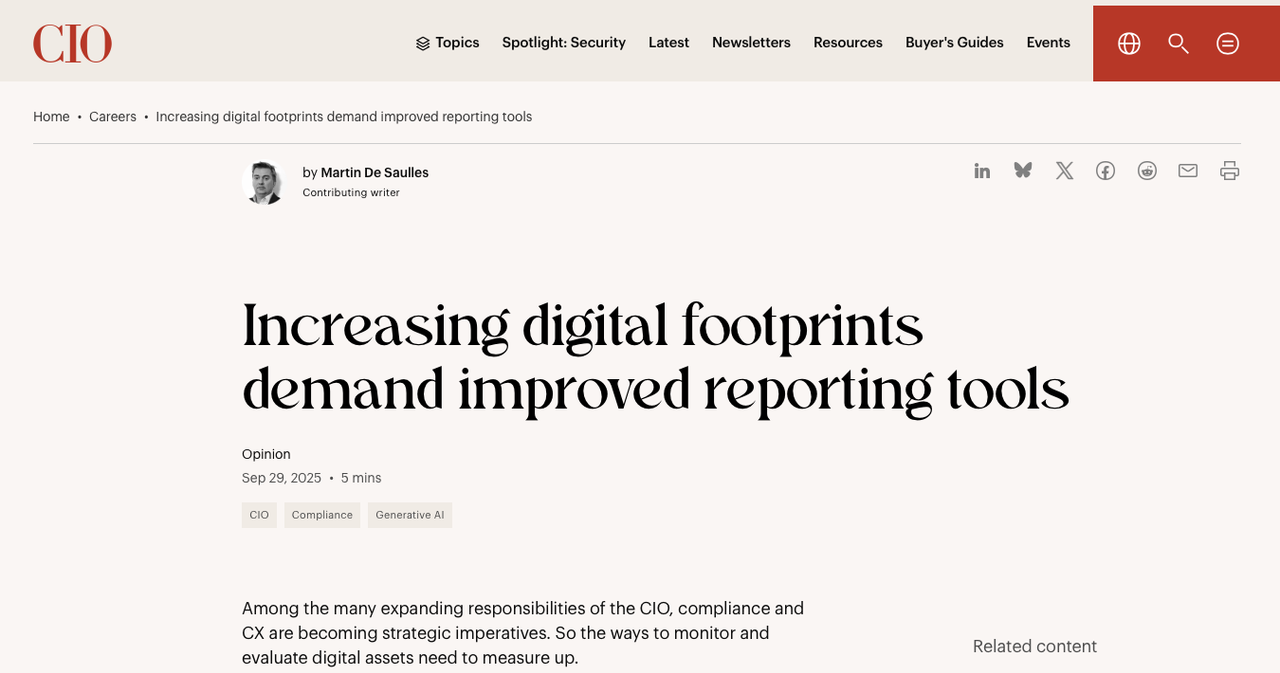13 Oct 2025 | General


Screenshot of the CIO.com article Increasing digital footprints demand improved reporting tools.
According to a recent article from CIO.com, lawsuits in the United States over websites that don’t meet accessibility laws are rising sharply. In the first half of this year, there were 2,014 cases under the Americans with Disabilities Act (ADA), a 37% increase from 2024. One major retailer, Fashion Nova, agreed to pay $5.15 million to settle a case about its website being inaccessible to blind visitors.
These examples show how digital responsibility is no longer just an IT issue; it affects every part of an organisation. From accessibility and security to data protection and customer experience, what happens online now carries real legal and financial consequences. Yet many organisations still lack a clear picture of how well they are managing these risks.
Why Visibility Matters
Most companies have several teams looking after their digital presence. Marketing focuses on the customer experience, legal handles compliance, and IT manages systems and security. Each team produces reports, but they often focus on their own priorities and use technical language that can be difficult to compare.
That means decision-makers often end up with too much data but not enough clarity. Without a single, trusted view of what’s really happening, it’s hard to tell whether digital investments are delivering value or if risks are being properly managed.
A New Kind of Reporting
To solve this, organisations need a digital reporting approach that gives a clear, high-level view of what’s working and what isn’t.
This type of reporting should make it easy to see three key things:
1. Capability – how strong your digital systems and teams are
2. Value – what return you’re getting from digital investment
3. Risk – where you could be exposed or fall out of compliance
Think of it like a health check for your digital performance. It gives leaders confidence that the organisation is secure, compliant, and using technology in the best possible way.
CIOs Need the Big Picture
By turning complex technical details into straightforward business information, CIOs help everyone, from senior leaders to department heads, understand how digital activity supports growth, protects the brand, and reduces risk.
Having one clear picture of your digital performance isn’t just convenient; it builds confidence across the whole organisation. According to accessibility expert and COO Lloyd Golley, the Chief Information Officer (CIO) plays a key part in making this happen.
“CIOs need to implement a single, CIO-owned reporting standard focused on risk and value, bringing together insights from content management, security, and customer experience (CX),” says Golley.
This unified approach helps teams and leaders alike:
• Understand how digital work supports wider business goals
• Spot and fix compliance or security issues early
• See the real value of technology investments
• Know that digital risks are being managed effectively
When information is clear and consistent, decisions become faster and better informed. Organisations can shift from reacting to problems after they occur to preventing them before they happen. It is about being proactive, not just compliant, and that benefits everyone from staff and customers to shareholders.
Check Where You Stand
Good digital oversight starts with knowing your current position.
Use our free website compliance checker to see how your website performs and where you might face risk. It’s a quick and simple way to begin improving your digital visibility and confidence.
Check your website now: https://sitemorse.com/check
Further Reading
For a deeper dive into this topic, see the CIO article Increasing digital footprints demand improved reporting tools.
Read the full article on CIO.com:

